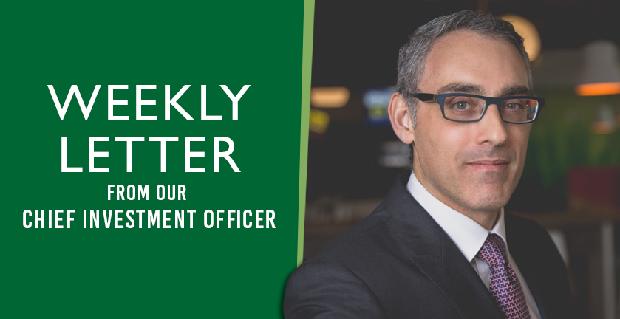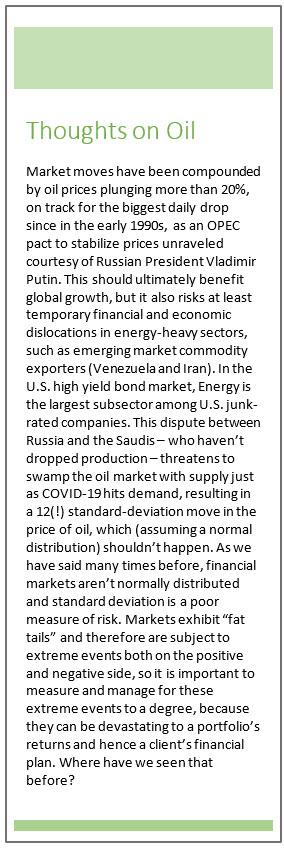
Dear Investors,
It’s fair to say that last week was quite an emotional one for investors, and the volatility is continuing today. The rapid pace of price changes on equity and bond markets is unsettling, even for those of us who have been through this many times before. The advantage of experience is we have not waited for the storm to hit us to prepare the Counsel and IPC Private Wealth “ships”. Rather, we positioned our portfolios to participate in the market’s upside, but we were also prepared for the weather to turn. While our downside protection strategies meant that we did not capture all of the market’s upside over the last 12+ months, it has given us the ability to better withstand the sharp shocks we are seeing.
For Paul and me, and the rest of our team, the ability to detach ourselves from the noise and think about the next six to 12 months is key to ensuring that we guide these ships through this storm and be positioned for better weather.
We are thinking a lot about what is to come. From our perspective, the market turmoil sparked by COVID-19 is reminiscent of market conditions after the 9/11 terror attacks in 2001 and the onset of the global financial crisis in 2008. In these two extreme events, equity markets continued to decline over the following six to 12 months, suffering total drawdowns in excess of 50%. Also, in both 2001 and 2008, volatility continued to rise after the initial shock, peaking a few months before the market bottom. So far, the COVID-19 pandemic and oil-price collapse have led to a ~25% drawdown in equity markets and a spike in forecast volatility to over 40%. It remains to be seen whether the current crisis will follow a pattern similar to 2001 and 2008.
For context, the S&P 500 Index fell 25.41% last week, and we are seeing more of the same this morning. What is the precedent for a move of this speed and scale?
Since 1926, there have been only 15 other instances where the U.S. benchmark was down 10% or more from Friday close to Friday close. Some of these include:
- The Great Depression: a cluster of nine weeks between 1929-33
- March 1938: the outworking of the infamous Federal Reserve policy mistake of 1937
- May 1940: when Nazi Germany enacted the Manstein Plan to conquer most of Northwest Europe
- October 1987: Black Monday
- April 2000: Dot-Com Bust
- September 2001: 9/11 terrorist attacks
- October 2008: Lehmann Brothers declares bankruptcy
So, those are some pretty serious comparisons. Sadly, there is little pattern in terms of what happens next. Of the 15 instances, six experienced further negative performance over the subsequent 12 months and nine were positive. The worst-case scenario was -25%, the best +117%. Which might it be this time around? Our belief is that it’s more likely to be positive.
 The scale of the current decline suggests that investors are pricing for a “U”- shaped recovery rather than a “V”-shaped one. In other words, investors believe that COVID-19 is not a one-quarter hit to earnings which is quickly recouped, but instead a sustained impairment of earnings. The defensive trend following strategies respond more effectively in ‘U’-shaped scenarios.
The scale of the current decline suggests that investors are pricing for a “U”- shaped recovery rather than a “V”-shaped one. In other words, investors believe that COVID-19 is not a one-quarter hit to earnings which is quickly recouped, but instead a sustained impairment of earnings. The defensive trend following strategies respond more effectively in ‘U’-shaped scenarios.
Over the weekend, the U.S. Federal Reserve enacted further emergency easing, and other central banks may likely follow suit. It is quite possible that once the initial reaction subsides we may see some dramatic positive market moves.
The equity selloff precipitated by COVID-19 forces us to think hard about how to classify market downturns. Not all downturns are equally disastrous: the effect of the collapse of the technology bubble in 2001 was of a different order of magnitude compared to the bear market triggered by the collapse of Lehman Brothers in 2008. The former was an event whose effects were largely confined to the financial markets, the latter a full-scale global banking crisis.
One way of thinking about the COVID-19 virus is to place it within a threefold classification: a financial market event, a real-economy event or a banking crisis. The first could be defined as a large-scale derating of financial assets, which has a minimal effect on growth rates; the second a selloff triggered by a catalyst which affects spending and growth in the real economy (therefore causing market participants to sell their holdings in expectations of lower earnings); and the third an event which not only encompasses the first two, but also causes the collapse of financial institutions and inhibits the creation of credit in the real economy.
The COVID-19 selloff is clearly rooted in the dislocation in the real economy. The virus has caused many workplaces and schools to close, restricted travel and caused the cancellation of both public and sporting events, with a consequential effect on supply chains for many businesses. Self-isolation also poses a threat to demand, as those who remain at home will reduce non-essential consumption.
However, the outbreak only escalates to a banking crisis if its duration persists. A short, sharp reduction in activity can be discounted in asset prices. A shock to earnings, while unwelcome, isn’t the end of the world. However, there may be some danger if the slowdown in activity causes cashflow problems for businesses, creating non-performing loans for banks. We are confident in our asset allocation and will position our portfolios accordingly should the probability of such an event increase.
The ultimate depth and duration of the COVID-19 economic impact are highly uncertain, but we still believe this initial shock should be temporary as the outbreak will eventually dissipate and economic activity will normalize.
Our portfolios are designed to be agile in situations such as this.
- We moved closer to a neutral asset mix a few weeks back as we believed there wasn’t a catalyst for taking on significant risk in our portfolios.
- The inclusion of the Multi-Factor equity strategies within our Strategic Portfolios increased our exposure to more defensive high profitability and low investment factors (often referred to collectively as Quality) and the minimum volatility factor.
- Our defensive strategies, Counsel Retirement Income Portfolio, Counsel Global Trend Strategy, Counsel Defensive Global Equity, Counsel Global Low Volatility Equity and the IPC Multi-Strategy Alternatives Pool are performing as we expected in this environment.
- We are tactically rebalancing our portfolios, making small incremental shifts to take advantage of the market swings and capture the excesses on both ends. We recognize that this volatility will be with us for some time and therefore we need to be intelligent in our rebalancing, so we are making smaller incremental moves that are better than large rebalances into a weakening volatile market.
Our portfolios were built for this, and we believe they are poised to hold up well in this environment. Currently our portfolios are down less than the market, and down less than many of the funds we have been compared with.
We are and will continue to plan out various market scenarios, and at the appropriate time will position our portfolios to take advantage of the eventual upswing.
In closing, as your Portfolio Management Team, we continue to monitor and evaluate markets daily and we will make adjustments as needed. We are seeing the benefit of effective portfolio construction and the diversification of our investment strategies. This is an uncomfortable ride, but be sure that along with our investment specialists we continue to be pro-active in managing the risk in your portfolios.

Corrado Tiralongo
Chief Investment Officer
Counsel Portfolio Services | IPC Private Wealth
